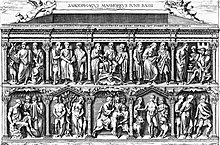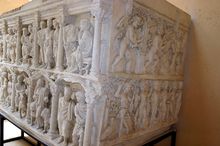Sarcophagus of Junius Bassus



The Sarcophagus of Junius Bassus is a marble
Together with the
Junius Bassus
Junius Bassus was an important figure in late antique Rome, a senator who was in charge of the government of the capital as
Style
The style of the work has been greatly discussed by art historians, especially as its date is certain, which is unusual at this period.[3] All are agreed that the workmanship is of the highest quality available at the time, as one might expect for the tomb of such a prominent figure.

The sarcophagus in many respects shows fewer features of the
The setting in the niches casts the figures against a background of shadow, giving "an emphatic chiaroscuro effect"[5] – an effect much more noticeable in the original than the cast shown here, which has a more uniform and lighter colour. The cast also lacks the effects created by light on polished or patinated highlights such as the heads of the figures, against the darker recessed surfaces and backgrounds.
Ernst Kitzinger finds "a far more definite reattachment to aesthetic ideals of the Graeco-Roman past" than in the earlier Dogmatic Sarcophagus and that of the "Two Brothers", also in the Vatican Museums.[6] The form continues the increased separation of the scenes; it had been an innovation of the earliest Christian sarcophagi to combine a series of incidents in one continuous (and rather hard to read) frieze, and also to have two registers one above the other, but these examples show a trend to differentiate the scenes, of which the Junius Bassus is the culmination, producing a "multitude of miniature stages", which allow the spectator "to linger over each scene", which was not the intention of earlier reliefs which were only "shorthand pictographs" of each scene, only intended to identify them.[7] He notes a "lyrical, slightly sweet manner" in the carving, even in the soldiers who lead St Peter to his death, which compares to some small carvings from the Hellenized east in the Cleveland Museum of Art, though they are several decades older.[8] Even allowing for "the gradual appropriation of a popular type of Christian tomb by upper-class patrons whose standards asserted themselves increasingly both in the content and in the style of these monuments", Kitzinger concludes that the changes must reflect a larger "regeneration" in style.[9]
Iconography
The carvings are in
The scenes on the front are:
The tiny
The sides have more traditional Roman scenes of the
Scenes with Christ
The emphasis on scenes of judgement may have been influenced by the career of Bassus as a magistrate, but all the scenes shown can be paralleled in other Christian works of the period.
In all the three scenes where he appears Christ is a youthful, beardless figure with shortish hair (though longer than that of other figures), which is
Before Pilate Christ also carries a scroll, like a philosopher.[17] Pilate, perhaps worried by Jesus's reputation for miracles, is making the gesture Italians still use to ward off the evil eye.[18] Pilate has a mild and passive appearance, contrasting strongly with the powerful and determined expression of the figure in low relief profile behind him on the wall, the only figure in these scenes depicted in this style and technique. If he is not just one of Pilate's subordinate officers, he may be intended as a portrait or statue of the emperor; Roman official business was usually conducted before such an image, upon which (under the deified pagan emperors) any oaths required were made.
The lower scene loosely follows the entry ("adventus") of an emperor to a city, a scene often depicted in Imperial art; Christ is "identified as imperator by the
The inclusion of the pagan figure of Caelus may seem strange today, but since the
Other scenes
The Old Testament scenes depicted were chosen as precursors of Christ's sacrifice in the
The scenes prior to the martyrdoms of Peter and Paul, both common in Early Christian art, show the same avoidance of the climactic moments which were usually chosen in later Christian art. But they demonstrate to the viewer how the heavenly crown could be achieved by ordinary Christians, although the Imperial persecutions were now over. Both scenes also took place in Rome, and this local interest is part of the balance of Christian and traditional Roman gestures that the sarcophagus shows.[24] The reeds behind Paul probably represent the boggy area of the city where Paul's execution was traditionally believed to have happened.[25] Peter's execution was believed to have happened close to his grave, which was within a few feet of the location of the sarcophagus; both executions were believed to have occurred on the same day.
Notes
- ^ Journal of Early Christian Studies, Leonard Victor Rutgers, The Iconography of the Sarcophagus of Junius Bassus (review of Malbon book) – Volume 1, Number 1, Spring 1993, pp. 94–96; for Janson it is also the "finest Early Christian sarcophagus", and Kitzinger, 26, calls it the "most famous".
- ^ or 1595, see Elsner, p. 86n.
- ^ Reece, 237
- ^ Reece, 240
- ^ Calvesi, Maurizio; Treasures of the Vatican, p.10, Skira, Geneva and New York, 1962
- ^ Kitzinger, 26
- ^ Kitzinger, 22–26, 25 quoted.
- ^ Kitzinger, 26–27, 26 quoted.
- ^ Kitzinger, 28
- ^ Hall, 80
- ^ Hall, pp. 79–80
- ISBN 978-0-521-03011-3
- ^ Lowrie, 90, and J.W. Appell
- ^ Texts, though nb the descriptions of the iconography here are not accurate.
- ^ Elsner, 87
- ISBN 0-7195-3971-4. Hellemo, pp. 65–70 discusses the place of the work in the development of the traditio legis subject.
- ^ Janson
- ^ Lowrie, 89 – the cornu, a fist with the index and little finger extended.
- ^ Eduard Syndicus; Early Christian Art; p. 97; Burns & Oates, London, 1962, and see Edwards & Woolf, op & page cit.
- ^ Adventus Domini, p. 100, Geir Hellemo
- Floro, Epitome 1.40 (3.5.30): "The Jews tried to defend Jerusalem; but he [Pompeius Magnus] entered this city also and saw that grand Holy of Holies of an impious people exposed, Caelum under a golden vine" (Hierosolymam defendere temptavere Iudaei; verum haec quoque et intravit et vidit illud grande inpiae gentis arcanum patens, sub aurea vite Caelum). Finbarr Barry Flood, The Great Mosque of Damascus: Studies on the Makings of an Umayyad Visual Culture (Brill, 2001), pp. 81 and 83 (note 118). El Oxford Latin Dictionary (Oxford: Clarendon Press, 1982, 1985 reprinting), p. 252, entry on caelum, cita a Juvenal, Petronio, and Floro como ejemplos de Caelus o Caelum "with reference to Jehovah; also, to some symbolization of Jehovah."
- ISBN 0-85331-270-2
- ISBN 0-7011-2514-4
- ^ Elsner's main theme
- ^ Lowrie, 89
References
- Hall, James. A History of Ideas and Images in Italian Art, p. 80, 1983, John Murray, London, ISBN 0-7195-3971-4
- Janson & Janson, History of Art: The Western Tradition, Horst Woldemar Janson, Anthony F. Janson, 6th edn., Prentice Hall PTR, 2003, ISBN 978-0-13-182895-7
- ISBN 0-571-11154-8(US: Cambridge UP, 1977)
- Lowrie, Walter. Art in the Early Church, 1947, Read Books reprint 2007, ISBN 978-1-4067-5291-5
- Reece, Richard, in: Henig, Martin (ed), A Handbook of Roman Art, Phaidon, 1983, ISBN 0-7148-2214-0
- Oxford Art Encyclopedia
Further reading
- Elizabeth Struthers Malbon. The Iconography of the Sarcophagus of Junius Bassus. Princeton, NJ: Princeton University Press, 1990
- ISBN 978-0-87099-179-0; full text available online from The Metropolitan Museum of Art Libraries
